13 Global Analysis of Environmental Justice – Sarah Chen
Environmental Justice – Global Perspective
Introduction:
Different populations have always been disproportionately affected by issues related to the environment. These issues have only intensified and increased in severity with the surge in extreme weather events and rising global temperatures. From pollution to resource exploitation to climate change, we will be exploring how social determinants of health relate to environmental impacts through income inequality, race, and other structural inequalities. We will also explore global initiatives, organizations, and milestones specific to environmental justice on the global scale. Finally, current applications of environmental justice programs will be evaluated for their effectiveness and future implementation.
On a global scale, countries with a lower GDP, labor primarily oriented on exports, and lower education rates, are at high risk for the negative physical and mental effects of environmental hazards. The United Nations (UN) identifies “Least Developed Countries” as those with a “low level of socioeconomic development, scarcity of domestic financial resources, and a historically weak development capacity”. Their list consists of 44 countries including Bangladesh, Haiti, and Yemen to name a few. According to a study done by the UN on disaster risk reduction in least developed countries (LDCs), LDCs have only made up around 1% of global emission but have suffered a 5x increase in climate-related hazards since the 1970s (UNDRR 2022). For example, natural disasters and climate events have drastically different effects on not only health outcomes but also economic effects on a country.
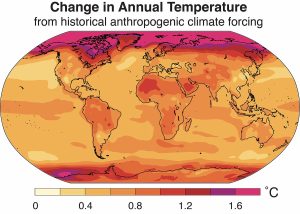
(Diffenbaugh and Burke Stanford University 2019)
Countries without proper risk prevention, mitigation, and relief efforts are vulnerable to these long-term impacts. Often many of these countries lack the proper infrastructure to rebuild. They don’t have the same infrastructure as we see with emergency response and preparation in the United States. Due to the fact that climate disasters and environmental health are not always top priority as there are other pertinent issues like civil rights, economic development, corruption, and warfare. Also, within these countries, these issues are exacerbated for different indigenous and minority groups.
I will be examining specific environmental issues in relation to equity including climate change, pollution, and resource use. Many of these effects and issues are intertwined but present unique disparities within different marginalized populations across the world. According to the International Institute for Environment and Development (IIED), LDCs have suffered 69% of deaths from climate-related disasters compared to 31% of the rest of the world (IIED 2020). For countries in an already economically vulnerable state, increases in disasters like hurricanes, floods, and droughts further perpetuate not only physical dangers but also economic and social dangers. Many of the LDCs are agrarian societies and primary sector economies whose labor force is directly affected by the weather. Agriculture is more vulnerable in countries where rainfall patterns and soil conditions directly determine crop production and income. With increasing issues of soil salinization and water scarcity, growing regions are becoming more arid. The World Bank Group estimates around 80% of the global population most at risk from hunger from climate change are those countries in South Asia, Southeast Asia, and Sub-Saharan Africa (WBO 2022).
Climate Change:
As highlighted, environmental justice on the global scale is more vital now than ever as issues related to the environment continue to be exacerbated. To start, I will be focusing on climate change and burdens that countries disproportionately bear. I will also go into case studies and examples from countries specific to the issues discussed.
Environmental justice is largely focused on the structural and economic differences that countries face. As I discussed earlier, countries that are not as economically developed have a harder time recovering from extreme weather events despite not contributing as much to global greenhouse gas emissions. Another compounding issue is that overtime this difference will increase the economic gap between wealthier countries and developing countries. Unable to recover and rebound from destructive weather events, developing countries will be forced into a continuing cycle of vulnerability. According to the Council on Foreign Relations (CFR), any efforts to minimize the large gaps between countries will become further damaged. There are limited systems of resiliency in place to withstand these long-term changes. Therefore, displacement due to weather and environmental instability will also continue to increase across the world.

(Council on Foreign Relations Education 2024)
Climate change not only further perpetuates the economic and social gap between countries but also within countries. In many lower developed countries, women are at highest risk to be affected by climate change (UN 2024). When resources become scarcer as a result of droughts and other weather events, women bear the burden of securing food and other resources. Also, as food becomes scarcer, women are also the ones eating last, which puts them at the most vulnerable spot within the family hierarchy.
Climate changes also put marginalized populations at higher risks. This applies to all countries including the United States but is a more concerning issue in certain countries because many of these countries already have issues with accessibility to essential resources. Another larger issue in these countries is displacement of indigenous populations. The Council on Foreign Relations reports that many indigenous populations in Bangladesh, Cameroon, and Pakistan have been the most affected by this issue.
To summarize many of these increasing disparities, Stanford University conducted a study correlating climate change to global economic inequality. The study focused on the time period between 1961 to 2010, and the findings were telling. They found that “global warming decreased the wealth per person in the world’s poorest countries by 17 to 30 percent”. The study also found that “the gap between the group of nations with the highest and lowest economic output per person is now approximately 25 percent larger than it would have been without climate change” (Stanford 2019). These findings are significant because they show and emphasize that global warming does not just affect the physical environment around us but it also drastically changes every aspect of economic development that a country experiences.
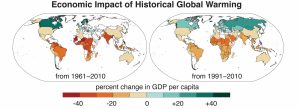
(Diffenbaugh and Burke Stanford University 2019)
This study also emphasizes the fact that tropical countries have been more severely impacted by global warming compared to middle latitude and other temperature-climate nations. Countries including India and Nigeria are examples of warmer countries that have been economically hindered compared to cooler countries like Norway and Sweden which have actually benefited from the increasing temperatures. Cooler countries like Sweden have benefited on a short-term scale because of increased agricultural and growing viability with warmer temperatures. Countries which have a warmer year-round temperature are already at a disadvantage when it comes to climate change, so many of these negative effects have continued compounding over time.
Along with this study from Stanford University, The US Global Leadership Coalition reports that “the effects of climate change could push an additional 100 million people below the poverty line by 2030”. Another factor of the economy that will be threatened relates to agriculture and exports. The World Bank emphasizes the fact that numerous major commercial ports in developing countries including Tanzania, Brazil, India, and
China is at risk of being submerged due to rising sea levels. This is another example of how climate change will continue affecting national economies.
Delving further into resource accessibility, many developing countries are Agrarian and depend heavily on the success of agriculture for their livelihoods. Agriculture has been hit hard by the changes in climate with biodiversity decreasing and harsher conditions for crops to grow. According to the Food and Agriculture Organization, “more than half of the people in developing countries live in rural communities” that depend on agriculture. Communities in these countries depend on the crops they grow for both sustenance and for income. Unlike in the US, where industrialized farming has taken over agriculture, farmers are extremely vulnerable to even slight changes in the climate.
A more direct impact of climate change that differs from country to country is the impact of emerging and reemerging diseases. As sea levels rise and the global average temperature increases, certain insects began to thrive including mosquitos. Mosquitos breed in water and are more resilient in warmer temperatures. This continues to pose a threat as hurricanes have become a more severe natural disaster. With the increase of more resilient mosquitos, we see Malaria, Dengue Fever, and Zika become more and more prevalent as well.
These diseases which are highly controlled in westernized countries do not pose the same threat as they do in lower developed countries. Many lower developed countries already have issues with controlling and treating these vector-borne diseases, so it will only pose a bigger threat. The World Health Organization (WHO) estimates that “a warmer climate could lead to an additional 250,000 dying of diseases including Malaria each year”. Not only do vector-borne diseases pose a threat but climate change will also increase the rate of water-borne diseases. With hurricanes increasing in intensity, we also see unsafe drinking water increase. Unsafe water contributes largely to Cholera which is when the water becomes contaminated with sewage or feces. Cholera also thrives in warmer water which flooding from hurricanes provides the ideal environment for.
As mentioned earlier, there is also a social loss attributed to global climate change. As populations, communities, and individuals begin to become displaced, what’s left behind isn’t just the physical resemblance of their home but all aspects of culture. An example of this is the Pacific Islands which are being threatened with rising sea levels and forced migration. The UN reports that many of the critically endangered languages come from the Pacific Islands. As citizens of these countries migrate, their language becomes vulnerable to being lost and forgotten. Language is not just words but is also the center of a culture and a country’s way of life. There are many effects of climate change that people may not immediately think of including cultural erosion.
To focus on a specific region of the world, Africa accounts for only two to three of global greenhouse emissions but is expected to experience losses of 50 billion every year due to climate related issues (World Meteorological Organization 2023). Somalia, in East Africa, is specifically one of the most vulnerable countries in the world to climate change. In 2020, the country began to face the worst drought it has seen in forty years which scientists have believed to be a result of human actions contributing to climate change. The prolonged drought in Somalia resulted in a very large humanitarian crisis with extremely low amounts of available water and many animals unable to survive as well.

(The United Nations 2021)
In Somalia, climate change is heavily intertwined with the political unrest and instability (International Climate Crisis 2024). Al-Shabaab is a militant group that has been trying to gain control over the government for many years. They’ve been able to take advantage of the droughts and humanitarian crisis to gain more power. Al-Shabaab has destroyed water infrastructure around the country, using water access to manipulate and exert control over different towns.
There is no direct causation between climate change and the surge of violence, however, climate change exacerbates political issues along with all of the economic instability it brings. Climate change has further fueled the social violence and conflict within the countries, and the citizens are the ones who are suffering. Climate change continues to compound issues countries are already facing which poses even more complex challenges than they are currently facing. This is an important example as it shows how the effects of climate change extend beyond physical changes we see with our eyes. Our climate affects entire systems within a country, drastically shifting the social and political landscapes.
Another country that has been facing challenges is Chile. Chile has been facing a drought for the past 15 years and water reservoirs are continuing to be depleted. Drier conditions have fueled wildfires across Chile as well forcing people out of their homes. The UN reports that the wildfire in February of 2023 killed 26 people, affected over 11,000 farmers, and killed over 30,000 animals. The conditions in Chile don’t only affect the people within the country but also those countries around it. Uruguay and Argentina depend on agricultural exports from Chile, so surrounding South American countries have also seen the impacts of the changing climate (Reuters 2024). As countries’ exports are affected by increasingly severe weather patterns, the global economy and trade will be hit as well. Environmental justice largely intertwines with global trade as certain countries bear the brunt of supplying the world.
Resource Exploitation:
According to the London School of Economics and Political Science, high-income countries account for 16% of the world population but are responsible for approximately 74% of cumulative excess resource use worldwide. The concern regarding this is that the countries that supply the global market are at risk for exploitation because of the large role they play. This exploitation includes both social exploitation and environmental exploitation. The concern of resource exploitation has roots in colonization because many of the countries that are trying to keep up with the global demand are not in a position to supply a mass amount of raw goods. This demand and pressure that certain countries feel and have dealt with for hundreds of years largely goes back to British colonization.
During the 1880s, the height of rapid British expansion, many countries in Africa, the Caribbean, and parts of Asias were used to grow goods like food and extract raw materials from minerals. This exploitation created a precedence of dependency and a system of supplying the wealthier countries.
One country that has experienced these effects of resource exploitation is Côte d’Ivoire. Although they were colonized by France and not Britain, their cocoa industry shows how they have disproportionately faced environmental degradation that is out of their control. Côte d’Ivoire supplies roughly 40% of the world’s cocoa but due to high demand and low compensation. A farmer receives roughly $2.00 per kilogram (kg) of cocoa beans depending on the season (Bloomberg 2024).
Although many efforts have been made to increase the minimum amount paid per kg, it is still not sustainable for an income. As a result, farmers have made more of an effort, using as much land as possible to produce greater amounts of cocoa. This land use for cocoa has even expanded to national park land areas of preservation. Further, Côte d’Ivoire has lost over 90% of their forest cover according to the United Nations Environment Programme (UNEP). Along with this, they have also seen soil degradation affecting 60% of their arable soil. Côte d’Ivoire is a prime example of a country that has been struggling as they attempt to keep up with the unsustainable demand of cocoa. The entire agricultural system exacerbates the economic inequality of Côte d’Ivoire on a global scale.
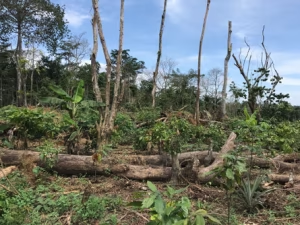
(The Guardian Magazine 2018)
They have also experienced increased violence because of the cocoa industry due to conflict over land and labor exploitation. The growing environmental and agricultural concerns only contribute to new economic issues among the people who are victims of a larger system that exploits their work.
Another example of resource exploitation lies in South America with Brazil and their cattle farming industry. Brazil is one of the largest exporters of beef in the world and with the demand for meat, they have resorted to expanding cattle farming in their country. However, this has come at a steep cost. To make room for more farms and grazing land for cattle, they have cut down mass amounts of trees and vegetation to make room. Along with cattle, Brazil is also a large exporter of soybeans, second after the United States, which alongside the cattle, creates an even larger environmental issue. One area that has been hit the hardest is the Amazon Rainforest with over 80% of the current rainforest deforestation caused by cattle grazing (International Institute for Sustainable Development 2024).

(Moriyama New York Times 2021)
The increased presence of industrial farming has also affected many indigenous communities in the Amazon. One indigenous group, the Awa, has experienced mass displacement because of illegal deforestation and expansion into protected land. Along with deforestation, the pesticides from the agriculture industry also pose a significant health risk to the species living in the Amazon. Over 5,000+ animal species and 40,000 plant species are at risk according to the Council on Foreign Relations. The loss of biodiversity and forest cover will only compound into global climate change and increase the global average temperature.
These ecological concerns all tie directly back to environmental justice because the populations housed within the Amazon and Brazilian ecosystems are not contributing to the environmental issues but are experiencing the most severe effects. They are also not in a position of power to put themselves at a spot where they do not have to rely on farming for their main sources of income.
What we have seen in Brazil also ties into the closely related issue of pollution. As mentioned briefly before, agricultural expansion and industrialization contributes to pesticide usage. The agricultural industry also plays a large role in global greenhouse emissions. In certain countries and regions of the world, pollution directly ties in with environmental justice.
Pollution:
Environmental exposures related to pollutants are usually examined on a national scale because certain neighborhoods and cities are at higher risk for exposure. This will be expanded on in the following chapter on national level analysis when we look at drilling, water pollutants, and air pollutants disproportionately affecting communities of lower socioeconomic status in the United States.
Similar ideas can be applied to countries around the world including India. A study done in 2023, led by Dr. deSouza from the department of Urban and Regional Planning at the University of Colorado Denver, “An environmental justice analysis of air pollution in India” evaluated socioeconomic status and religion correlation with pollutant exposure. The results confirmed similar issues that exist in the United Stated where exposures can be concentrated in one area, affecting certain areas more than others. Concentrated areas of extreme poverty had higher concentrations of PM2.5 compared to wealthier areas. Those with limited access to proper sanitation and electricity also had high concentrations of PM2.5.
India as a whole suffers the greatest number of deaths due to air pollution. Air pollution resulted in 1.67 million deaths in 2019 and accounted for 17.8% of total deaths in the country. Climate change also exacerbates pollution because of atmospheric stagnation, ground level ozone formation, and temperature driven particulate matter increase. These factors are more severe in India which leaves them more vulnerable to worsening air quality. This also puts those vulnerable populations within the country to be at even further risk including the elderly and adolescent populations.
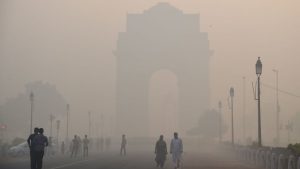
(BBC 2021 New Delhi Capital of India)
A study done by researchers from the Global Observatory on Pollution and Health at Boston College, the Indian Council of Medical Research, and the Public Health Foundation of India found that the effects of air pollution will have a drastic effect on the next generation of Indians because there are negative impacts on neurological developments. According to Philip Landrigan of Boston College, it has also been shown that prolonged exposure to air pollution is strongly correlated with a decreased IQ. There are a number of compounding factors of India including geography, intercity density, and industrialization that all play a role in the country’s environmental challenges. The disadvantages India faces in combating issues of air pollution reemphasize what environmental justice looks like on a global scale.
Another issue related to pollution is global waste dumping which primarily affects the global south. The United States specifically has shown to be shipping discarded waste including cars, laptops, telvisons, and clothes under the guise that they are recycling and helping others reuse older items. Cars have specifically been shown to be shipped in millions to Africa every year from The United States, Germany, and Dubai after they are deemed “defective” in the originating country (PBS NewsHour 2024).
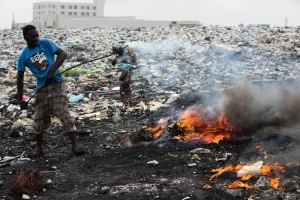
(Smithsonian Magazine 2016 E-Waste Dump Site in Ghana)
Although some of the items can be reused to a certain capacity, most of the items are shipped in excess and end up as waste in dump sites. The waste that is generated from the discarded items has extremely negative effects on the land itself, coastlines, and human health. As the materials break down on the land, they release chemicals which reach into the water and soil. As a result, human health is at high risk due to these chemical exposures. One country that has been severely affected by this is Ghana where they see an abundance of cars and electronics dumped into their country each year.
The waste sites that hold a majority of the electronics and vehicles are located in the capital primarily. There are workers who shift through the materials every day and take apart the electronics that come in. Many of these workers are children who do not work in any protective gear, exposing themselves to potentially hazardous materials. Some of the waste in these landfills is also subject to being burned which releases many toxic pollutants into the air. The lack of regulation and restrictions on where developed countries dump their waste portrays how certain nations are continually subjugated to environmental harm out of their control. The risk countries in the Global South face are due to exploitation and degradation enforced by wealthier nations. As emphasized throughout this chapter, regions of the world are not afforded the right to a safe environment to live in because of larger system inequalities.
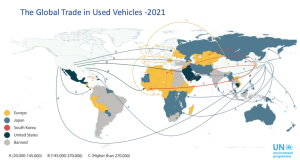
(United Nations Environment Programme 2021)
Current Initiatives to address global environmental justice:
Addressing environmental justice on the global scale can be difficult because it can be hard to identify what specific countries should be held liable for large-scale issues like climate change. It is also difficult to quantify how much a country should do to mitigate their negative environmental contributions. Responsibilities of more developed nations are not regulated, so there are many questions on moral obligations regarding mitigating environmental harms.
There are no current global proceedings to enforce environmental justice initiatives or hold countries liable for their actions. As a result, there are numerous organizations and programs the United Nations (UN) has implemented to help promote environmental justice efforts.
One important and notable action that has been taken by the UN is recognizing and validating environmental justice. In July of 2022, The United Nations declared the ability to live in a “Clean, healthy and sustainable environment” a universal human right. The recognition of environmental equity by the UN helped set a precedent going forward regarding environmental justice. This was important because it has created an important discussion and emphasis on disproportionate environmental harms.
The International Court of Justice (ICJ) has also taken steps to set similar precedents when it comes to a country’s environmental responsibilities. Although the court does not set any governing laws, they rule on environmental cases that cross country borders. Many of these cases have been related to pollution and environmental harms that involve multiple countries. For example, there has been a requested advisory opinion on State’s obligations regarding climate change. The opinion was requested by a number of island nations including Vanuatu which have been experiencing rapid rising sea levels due to climate change. Once this ruling has commenced, it will set a precedent going forward on the way states address their contributions to climate change. The ICJ plays a crucial role on the global level to influence countries actions.
An important initiative established under the UN is the Green Climate Fund which was established in 2010 under the UN Framework Convention on Climate Change. The Green Climate Fund stands as the world’s largest climate fund, supporting “developing nations” in capacity building related to the negative effects of climate change. The fund works by funding specific organizations within a nation to support their climate projects.
One example of a project that is currently being funded by the climate fund is a $15 million investment to a venture capitalist firm in Pakistan to fund startups focused on climate resiliency. Pakistan faces many similar issues to South Asian countries including rising temperatures, increased flooding, and water sanitation issues. The investment provides money to those projects specifically working in agriculture, water management, and renewable energy initiatives. The Green Climate fund is a large-scale project that centers on small, community level engagement to work towards climate resilience
Moving out of initiatives funded by the UN, there are numerous organizations that work on environmental justice advocacy including Friends of the Earth International and the Environmental Law Alliance worldwide. Friends of the Earth is the largest grassroots environmental federation, leading campaigns for environmental and social justice around the world.
In conclusion, there is still much work to be done on the global scale to address disparities between countries and impose stricter regulations on environmental actions that nations take.

(University of Dayton 2021)
Personal Reflection and Conclusion:

(Sarah Chen and her sister in a Canadian National Park – 2022)
Prior to this year, I was unaware of the topic of environmental justice and the impacts of environmental racism. As I’ve taken courses here in the College of Public Health for the past two years, I have learned of numerous water crises and industrial exposures affecting communities around the United States. However, I did not understand the systemic barriers that inflicted the harms of these environmental exposures. I now understand that systems put in place are directly targeted at vulnerable populations, and many issues of pollution concentrated in one area are not a coincidence.
As someone who hopes to work on the global level in public health, it was extremely important to me to explore environmental justice on a macroscale. An essential factor in public health is awareness and education surrounding issues that impact health outcomes. I believe there needs to be more awareness surrounding Western country actions and how they impact nations in the global south. Many of the examples of pollution and global waste dumping allowed me to adopt a new lens on global trade and exploitation.
Through the two environmental focused classes I have taken this Spring semester, Climageddon: Climate Change and Health and Health Work and the Environment, I have made strong connections between climate change and growing environmental burdens certain regions of the world bear. As I have talked to people living in Asia, they emphasize the rising temperatures and severity of water disasters increasing. Knowing people who live in vulnerable populations around the world makes this topic even more crucial in my efforts of health equity advocacy.
Learning about environmental justice has also increased my interest in public health policy and political science. On the global scale, there were many countries who experienced exacerbated political and societal tensions due to severe weather events like droughts. Understanding public health and determinants of health also requires a knowledgeable perspective on our economic and political structures. This semester-long research project has expanded my understanding of public health and the broad scope of issues that public health targets. Going forward, the information I learned during my research will help me make connections when examining and identifying barriers to health.
I believe that the right to a safe and healthy living space is a human right, and there is still much to be done on the global scale regarding environmental justice. Important steps have been taken in the past years to increase efforts. Crucial efforts I can bring as an individual are to increase conversation around environmental justice and help those around me learn about equitable global health solutions.
As awareness for global environmental justice grows, urgency will grow as well. Urgency to take action and support those nations at a more vulnerable geographic and political position will increase. We cannot address issues of our environment without addressing the inequalities that nations face. Inequities exist in every level of the environment, and we need to continue to highlight the voices around us who understand the issues at hand. Environmental justice is an effort from the individual level, the state level, country level, and global level.
References
Global Environmental Justice References (SC):
Author Anab Ovidie Grand, & Anab Ovidie Grand Policy Analyst. (2024, February 15). Navigating the crossroads of climate change, peace and security in Somalia. UNDP. https://www.undp.org/blog/navigating-crossroads-climate-change-peace-and-security-somalia
Climate change and the developing world: A disproportionate impact. USGLC. (2023, November 29). https://www.usglc.org/blog/climate-change-and-the-developing-world-a-disproportionate-impact/
Climate change has worsened global economic inequality. Stanford Doerr School of Sustainability. (2024, April 5). https://sustainability.stanford.edu/news/climate-change-has-worsened-global-economic-inequality
The climate crisis disproportionately hits the poor. how can we protect them?. World Economic Forum. (n.d.). https://www.weforum.org/stories/2023/01/climate-crisis-poor-davos2023/
Confronting the “two-headed monster” of environmental injustice. Stanford Doerr School of Sustainability. (2025, February 20). https://sustainability.stanford.edu/news/confronting-two-headed-monster-environmental-injustice
Council on Foreign Relations. (n.d.-a). Deforestation in the Amazon. Council on Foreign Relations. https://www.cfr.org/amazon-deforestation/#/en/section4
Council on Foreign Relations. (n.d.-b). How climate change worsens inequality. Council on Foreign Relations. https://education.cfr.org/learn/reading/climate-inequality
deSouza, P. N., Chaudhary, E., Dey, S., Ko, S., Németh, J., Guttikunda, S., Chowdhury, S., Kinney, P., Subramanian, S. V., Bell, M. L., & Kim, R. (2023, October 4). An environmental justice analysis of air pollution in India. Nature News. https://www.nature.com/articles/s41598-023-43628-3#citeas
Fighting climate change in Somalia’s conflict zones | crisis group. Crisis Group. (2021, October). https://www.crisisgroup.org/africa/horn-africa/somalia/316-fighting-climate-change-somalias-conflict-zones
Forest / Côte d’Ivoire: Interactive country fiches. Forest / Côte d’Ivoire | Interactive Country Fiches. (n.d.). https://dicf.unepgrid.ch/cote-divoire/forest
Global North and Global South: How Climate Change Uncovers Global Inequalities. Generation Climate Europe. (2022, May 10). https://gceurope.org/global-north-and-global-south-how-climate-change-uncovers-global-inequalities/
The global south faces a growing toxic waste crisis. Our Environment at Berkeley. (2024, November 19). https://ourenvironment.berkeley.edu/news/2024/11/global-south-faces-growing-toxic-waste-crisis
The human toll of air pollution in India. Boston College. (n.d.). https://www.bc.edu/bc-web/bcnews/nation-world-society/international/air-pollution-in-inda.html#:~:text=Air%20pollution%20in%20India%20resulted,at%20Boston%20College%2C%20the%20Indian
India. Clean Air Fund. (2025, April 11). https://www.cleanairfund.org/geography/india/
It’s time to address the devastating injustice of loss and damage. UNDP Climate Promise. (2025, April 29). https://climatepromise.undp.org/news-and-stories/its-time-addres-loss-and-damage-climate-change-negotiations-cop28
London School of Economics and Political Science. (n.d.). High-income countries responsible for 74 percent of excess resource use. https://www.lse.ac.uk/News/Latest-news-from-LSE/2022/d-Apr-22/High-income-countries-responsible-for-74-percent-of-excess-resource-use#:~:text=They%20found%20that%20high%2Dincome,%2D%20which%20over%2Dconsumed%20materials.
Mishra, S. (2025, May 5). Low-income communities bear the brunt of climate change. Earth.Org. https://earth.org/climate-changes-unequal-burden-why-do-low-income-communities-bear-the-brunt/
Mizutori, M. (2020, July 31). Global Atlas of Environmental Justice. Disaster risk reduction in least developed countries. https://www.undrr.org/implementing-sendai-framework/sendai-framework-action/disaster-risk-reduction-least-developed-countries#:~:text=LDCs%20have%20experienced%20nearly%2070
Persistent drought is drying out Chile’s drinking water | reuters. Reuters. (2024, March). https://www.reuters.com/world/americas/persistent-drought-is-drying-out-chiles-drinking-water-2024-03-20/
UNDPClimate. (n.d.). In pictures: How climate change is causing loss and damage around the world by UNDP climate. In pictures: How climate change is causing loss and damage around the world by UNDP Climate. https://undp-climate.exposure.co/how-climate-change-is-causing-loss-and-damage
United Nations. (n.d.-a). About least developed countries | office of the high representative for the least developed countries, landlocked developing countries and Small Island Developing States. United Nations. https://www.un.org/ohrlls/content/about-least-developed-countries
United Nations. (n.d.-b). About least developed countries | office of the high representative for the least developed countries, landlocked developing countries and Small Island Developing States. United Nations. https://www.un.org/ohrlls/content/about-least-developed-countries
United Nations. (n.d.-c). Report: Inequalities exacerbate climate impacts on poor. United Nations. https://www.un.org/sustainabledevelopment/blog/2016/10/report-inequalities-exacerbate-climate-impacts-on-poor/
World Bank Group. (2022, October 19). Climate explainer: Food Security and climate change. World Bank. https://www.worldbank.org/en/news/feature/2022/10/17/what-you-need-to-know-about-food-security-and-climate-change
World Health Organization. (n.d.). Environmental health inequalities. World Health Organization. https://www.who.int/europe/news-room/fact-sheets/item/environmental-health-inequalities
Yadav, N. (2024, November 25). Air pollution: Why most Indians choking on smog aren’t in Delhi. BBC News. https://www.bbc.com/news/articles/c36pr7wpn78
